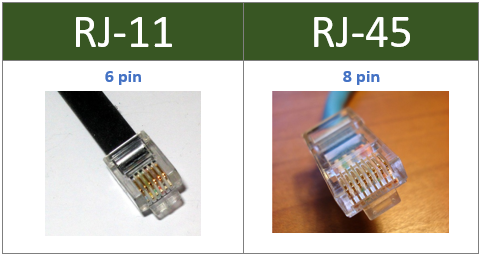Rj45 vs rj11
Rj45 vs Rj11
RJ45 and RJ11 connectors are both widely used in telecommunications and networking, but they serve different purposes due to their distinct designs and functionalities.
RJ45, which stands for Registered Jack 45, is a standard connector used primarily for Ethernet connections. It features eight pins and is commonly associated with Ethernet cables, including Cat5e, Cat6, and Cat6a cables. These cables are used to connect devices such as computers, routers, switches, and networked peripherals to create local area networks (LANs) and wide area networks (WANs). The RJ45 connector’s eight pins allow for four pairs of wires, enabling faster data transmission rates compared to its predecessor, the RJ11 connector.
In contrast, RJ11 connectors are primarily used for telephone connections. They feature four or six pins and are commonly found in telephone cables. RJ11 connectors are used to connect telephones, fax machines, modems, and other telecommunications devices to a telephone line, typically using twisted pair cables. Unlike RJ45 connectors, RJ11 connectors support only one pair of wires, limiting their data transmission capabilities to the frequencies suitable for voice communication.
One of the key differences between RJ45 and RJ11 connectors is their pin configuration and physical size. RJ45 connectors are larger and have more pins, making them incompatible with RJ11 sockets. However, RJ11 connectors can fit into RJ45 sockets, albeit loosely, due to their smaller size. This size difference ensures that RJ11 and RJ45 connectors are not interchangeable, preventing users from accidentally connecting incompatible devices.
Another difference lies in their applications and data transmission capabilities. RJ45 connectors support high-speed data transmission for Ethernet networks, making them essential for modern networking infrastructure. In contrast, RJ11 connectors are primarily used for voice communication and lower-speed data transmission, suitable for traditional telephone systems.
While RJ45 connectors have largely replaced RJ11 connectors in modern networking environments, RJ11 connectors still play a crucial role in telephone systems and certain legacy applications. Understanding the differences between these connectors is essential for proper network and telecommunications infrastructure design, ensuring compatibility and optimal performance for different types of connections.
In summary, RJ45 connectors are used for Ethernet connections in networking applications, supporting high-speed data transmission, while RJ11 connectors are used for telephone connections, primarily for voice communication and lower-speed data transmission. Despite their differences, both connectors serve important roles in telecommunications and networking, contributing to the seamless transmission of data and communication signals in various environments.

Comments
Post a Comment